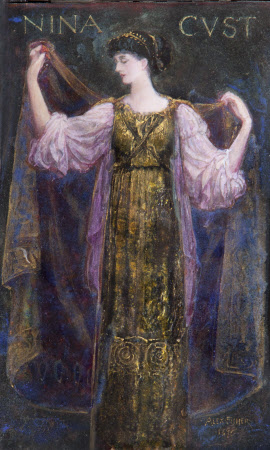Emmeline 'Nina' Mary Elizabeth Welby-Gregory, Mrs Henry John Cockayne-Cust (1867-1955)
Alexander Fisher (Stoke-on-Trent 1864 - 1936)
Category
Art / Oil paintings
Date
1898 (signed and dated)
Materials
Copper, iron, silver & painted enamel
Measurements
175 x 105 mm
Order this imageCollection
Belton House, Lincolnshire
NT 435439
Caption
Born Emmeline Welby-Gregory, ‘Nina’ Cust was a writer, editor, translator, poet and sculptor. She was descended from a line of intellectual women – her mother, Victoria, published extensively on the philosophy of language, while her grandmother Emmeline was a famous travel writer and poet. Cust is now recognised as one of the great creative women of Belton House, Lincolnshire. But this was not always the case. The troubled circumstances of her marriage to Belton’s heir, Harry Cust (1861– 1917), once dominated her narrative – an example of how women’s histories can become skewed or diminished. Some, but probably not all, of Nina Cust’s sculpture is known today. Signed portrait busts in plaster, marble and metal exist at Belton, and in its church there is a monumental marble effigy of Harry – staggering in its scale and emotional weight. Cust was herself the subject of portraits by the Arts and Crafts enamellist Alexander Fisher, and by the Symbolist painters George Frederic Watts and John Collier. Contemporary accounts speak of her artistic interests and aesthetic sensibility. She was twice depicted by the sculptor Sir Alfred Gilbert, his portrait of her exhibited at the Royal Academy in 1900. Amateur (non-professional) sculpture was practised by women in Nina’s social circle. Associated with an elite cultural group known as the ‘Souls’, it may have been through the influence of fellow Soul and exhibited artist Violet Manners, Duchess of Rutland (1856–1937), that she took up sculpture. Sir Alfred Gilbert, who was supported by Manners, may also have given her sculpture lessons. Indeed, Gilbert’s bust of Nina (Ackland Museum, Chapel Hill) and her self-portrait (NT 436834) share clear similarities. Nina Cust continued to sculpt well into the 20th century, exhibiting a bust of her niece Joan at the Royal Academy in 1906. In addition to practising sculpture, she published books and academic articles, and was the first to translate into English the French philologist Michel Bréal’s landmark book Semantics: Studies in the Science of Meaning (1900).
Summary
Coloured enamel painting on copper in an iron and silver art nouveau frame, Emmeline 'Nina' Mary Elizabeth Welby-Gregory, Mrs Henry John Cockayne-Cust (1867-1955) by Alexander Fisher (Stoke-on-Trent 1864 – 1936), signed and dated Alex Fisher 1898 and inscribed at top: NINA CVST. An art nouveau enamel plaque inscribed ' Nina Cust the artist' shown wearing a gold and pink robe. Emmeline Mary Elizabeth Welby-Gregory was the daughter of Sir William Welby-Gregory, 4th Bt. She married Henry John Cockayne-Cust (1861-1917), son of Henry Francis Cockayne-Cust (1819-1884) and Sara Jane Cookson (d.1867), on 11 October 1893. She died on 29 September 1955. Draughtswoman, sculptress and author. Her husband Harry Cust (1861-1917), was a hardened womaniser, who froze her out of his life and the circle of the 'Souls'. In spite of this she remained devoted to him, carving his tomb in Belton church and keeping a copy of the effigy in her drawing-room.
Provenance
Purchased with a grant from the National Heritage Memorial Fund (NHMF) from Edward John Peregrine Cust, 7th Baron Brownlow, C. St J. (b.1936) in 1984
Credit line
Belton House, The Brownlow Collection (acquired with the help of the National Heritage Memorial Fund by the National Trust in 1984)
Makers and roles
Alexander Fisher (Stoke-on-Trent 1864 - 1936), artist
References
Conroy, Rachel, Women Artists and Designers at the National Trust, 2025, p. 118, pp. 158-9

